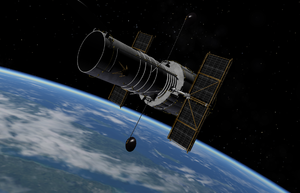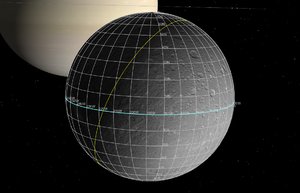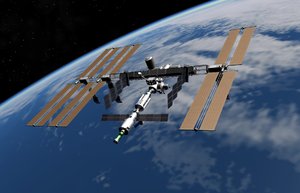Planetshine
In previous versions of Celestia, the only source of illumination was the sun (or suns, in multiple star systems.) But, light reflected from the surface of a planet can also be a significant. If you look at images of the International Space Station, you'll notice that the Earth-facing portion is lit by a bluish light reflected from the Earth's oceans. Recent images from the Cassini mission show the moons of Saturn with one hemisphere illuminated by the faint glow of Saturnshine. You can now observe these effects in the latest version of Celestia as well.
Globular clusters
Much work has been done to add a globular cluster catalog to the new version of Celestia. The catalog contains all 150 globular clusters of the Milky Way. The appearance of each cluster based on its measured diameter, core diameter, and King concentration (a parameter which gives the variation in star density with distance from cluster center.)
New sky grids
Celestia's sky grid feature has been completely rewritten and greatly improved. The spacing of lines in the grid will now adapt to the field of view, making it a much better tool for orienting yourself at high zoom levels. Coordinate labels are conveniently located at the edges of the view window. Celestia supports grids for several different coordinate systems, including equatorial, horizontal (altitude/azimuth), galactic, and ecliptic.
Selection cursor
A new animated cursor in 1.6.0 makes Celestia easier to use. The animation effect directs your eye to the selected item more quickly. An arrow at border of the view window points to the selection when it is offscreen. And, the cursor changes color when the selection is hidden by a foreground object. This visual cue helps you locate the selection in three dimensions.
Triaxial ellipsoids
While the shaped of most large objects in the solar system are closely approximated by flattened spheres, there are some exotic worlds that are noticeably elongated along one axis. The most extreme example of this is the dwarf planet Haumea (aka 2003 EL 61), which looks more like an American football than a familiarly spherical planet. Now that Celestia supports triaxial ellipsoid bodies, you can see the true appearance of such worlds.
Orbit color
Different orbit colors may be assigned for each object in a solar system. This can help you quickly distinguish the orbits of individual planets. Or, you can highlight the orbits of a group of related objects.
Dwarf planets
Since 2006, the International Astronomical Union has recognized a new class of object called a dwarf planet. To date, there are five bodies in our Solar System that have been assigned dwarf planet status. Version 1.6.0 brings Celestia up to date with the IAU decision and adds a dwarf planet class. You can visit all five dwarf planets and their known satellites.
New reference marks
Reference marks augment the 3D view with additional information that can help you understand the locations and relationships between solar system objects. Celestia 1.6.0 adds a longitude/latitude grid to aid in locating surface features. Another new reference mark is the terminator, the boundary between the day and night sides of a world.
Updated Cassini mission
The primary mission of the Cassini spacecraft lasted through mid-2008. In April 2008, an two-year extended mission was approved. The new version of Celestia includes the extended mission trajectory, so that you can follow Cassini around Saturn through 2010. The Huygens probe separation sequence has been improved using new features in version 1.6.0—watch Huygens separate from the main Cassini spacecraft and rendezvous with Titan three weeks later.
Updated ISS model
The new Celestia package includes a much more detailed model of the International Space Station, complete with all the modules added through 2008. With the new planetshine feature in 1.6.0, the updated ISS looks spectacular in low Earth orbit.




